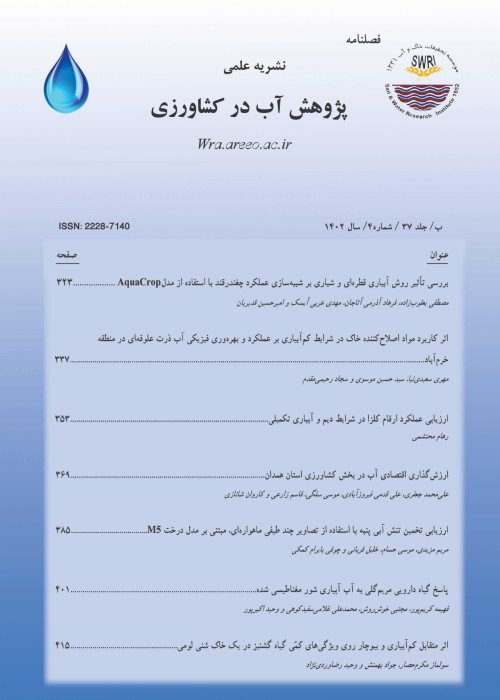Development of Multi Objective Optimization Model for Wastewater and Groundwater Conjunctive Use in Varamin Irrigation Network
Abstract:
Due to extensive agricultural activities on the plains and the use of chemical fertilizers containing nitrogen, significant amount of this element enter the aquifer. On the other hand, effluent of wastewater treatment plants is used in irrigation and drainage networks as an alternative or supplementary source of surface water. Therefore, adoption of strategies for reducing and controlling the amount of nitrogen that enters the soil and aquifer is an important issue. The aim of this research was to develop a cropping pattern optimization model by quantitative-qualitative conjunctive use of unconventional surface water (wastewater) and groundwater. The three objectives of the model were maximizing profits from cropping pattern, reducing nitrogen leaching, and improving the rate of aquifer recharge. In order to integrate management of wastewater and irrigation water resources, the nonlinear three-objective optimization model was run for 7 scenarios (one-objective, two-objectives, and three-objectives) in water year 2012-2013, for Varamin irrigation network. The input data required for the model were collected in two ways: regional testing and obtaining information from various institutions.Solving one-objective model by first objective (first scenario: improving the networks profit) showed the 49 percent improvement in the networks net profit. The second objective (second scenario: reducing of fertilizer consumption) showed 95% reduction of fertilizer consumption, and the third objective (third scenario: improving the aquifer recharge) showed 120% improvement in the aquifer recharge, in comparison to the current situation. Solving the three-objective model (seventh scenario: combined objectives of improving networks net profit, reducing fertilizer consumption, and improving the aquifer recharge) showed a reduction of 23% in cultivated area, 71% in nitrogen fertilizer consumption, and 13% in conjunctive withdrawals of wastewater and groundwater. Also, these reductions increase net benefit by 6%, aquifer recharge by 29%, and water productivity by 22%. Therefore, the seventh scenario was chosen as the best scenario. The results of this research could be adopted for optimum use of water resources, increasing farmers benefit, and decreasing nitrogen leaching in irrigation network projects. However, it is to be noted that, generally, use of wastewater for irrigation of food crops is not recommended.
Keywords:
Language:
Persian
Published:
Journal of Water Research in Agriculture, Volume:30 Issue: 4, 2017
Pages:
555 to 567
magiran.com/p1656164
دانلود و مطالعه متن این مقاله با یکی از روشهای زیر امکان پذیر است:
اشتراک شخصی
با عضویت و پرداخت آنلاین حق اشتراک یکساله به مبلغ 1,390,000ريال میتوانید 70 عنوان مطلب دانلود کنید!
اشتراک سازمانی
به کتابخانه دانشگاه یا محل کار خود پیشنهاد کنید تا اشتراک سازمانی این پایگاه را برای دسترسی نامحدود همه کاربران به متن مطالب تهیه نمایند!
توجه!
- حق عضویت دریافتی صرف حمایت از نشریات عضو و نگهداری، تکمیل و توسعه مگیران میشود.
- پرداخت حق اشتراک و دانلود مقالات اجازه بازنشر آن در سایر رسانههای چاپی و دیجیتال را به کاربر نمیدهد.
In order to view content subscription is required
Personal subscription
Subscribe magiran.com for 70 € euros via PayPal and download 70 articles during a year.
Organization subscription
Please contact us to subscribe your university or library for unlimited access!


